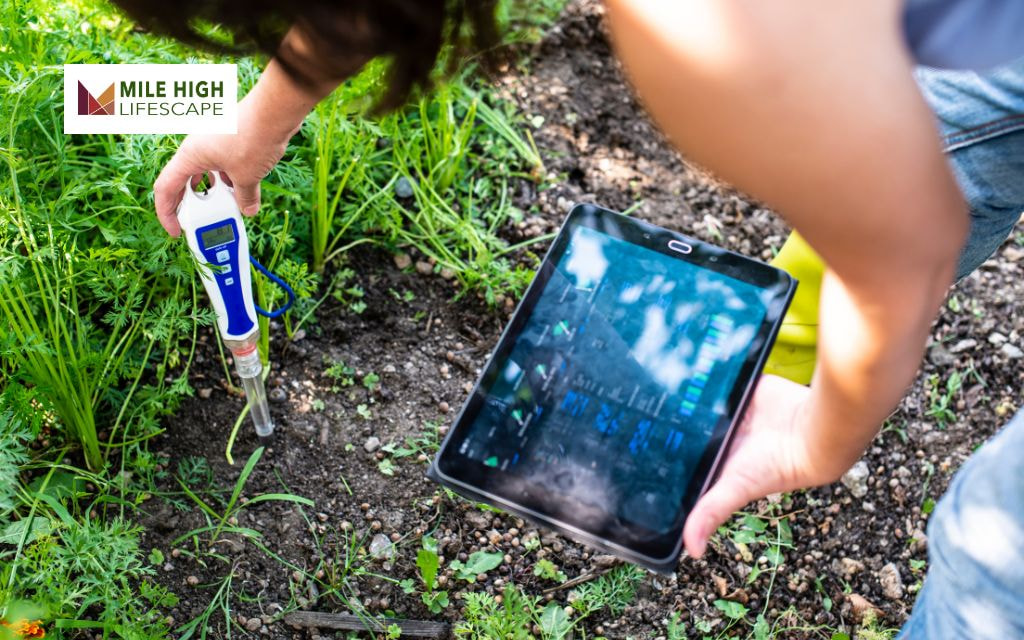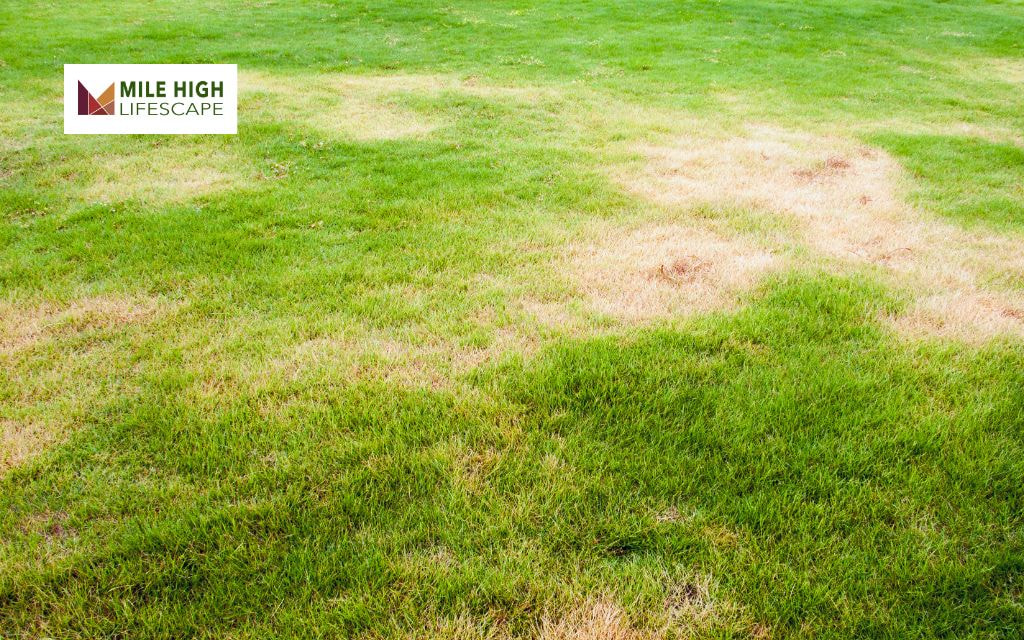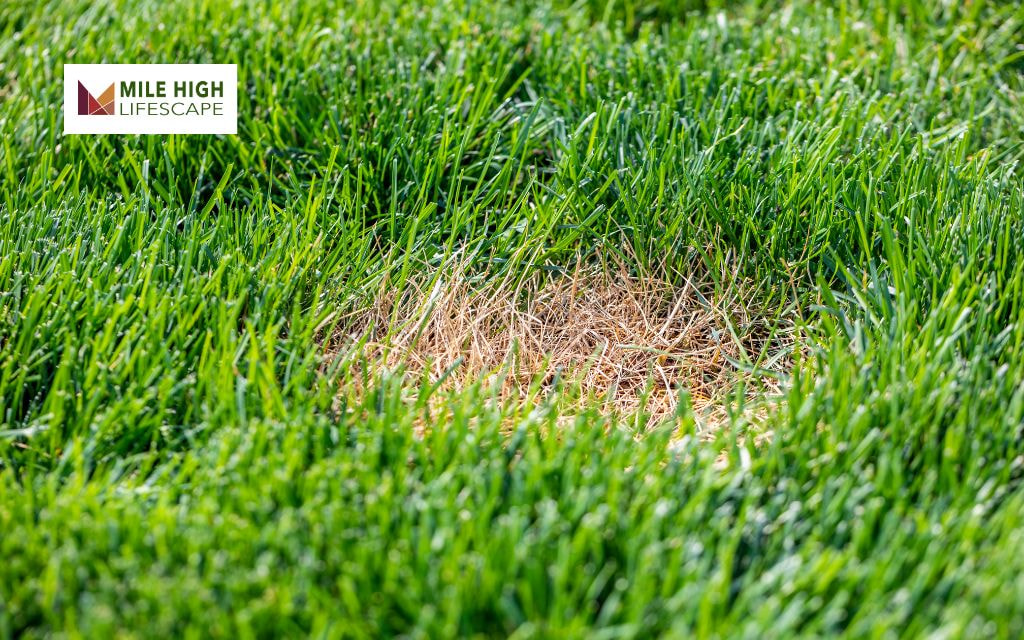Have you ever wondered why some lawns stay lush and green while others struggle? The answer often lies beneath the surface. Soil health fundamentally determines your lawn’s success, and pH balance plays a pivotal role in that equation.
When soil becomes too acidic, grass struggles to absorb essential nutrients regardless of how much you water or fertilize. Lime application emerges as a key solution for this common problem, restoring balance and revitalizing lawns across Denver.
In this comprehensive guide, Mile High Lifescape shares our expertise gained from two decades serving Colorado homeowners. We’ll explore when and how to apply lime properly, which type works best for different situations, and how to identify if your lawn needs lime treatment in the first place.
What is Lime?
Lime serves as a soil amendment derived from crushed limestone rock. Unlike the citrus fruit that shares its name, lawn lime functions as a pH balancer for your soil.
The two primary types include:
- Calcitic Lime: High in calcium carbonate, ideal for soils needing calcium but sufficient magnesium
- Dolomitic Lime: Contains both calcium and magnesium carbonates, perfect for soils lacking both nutrients
Agricultural lime fundamentally works by neutralizing soil acidity. The calcium and magnesium compounds react with acidic components in the soil, raising the pH level and making nutrients more accessible to grass roots. This process transforms locked-up nutrients into forms plants can readily use.
Landscapers and farmers have relied on limestone amendments for centuries, making it one of the oldest and most trusted soil improvement techniques.
Understanding Soil pH and Its Impact on Lawn Health
Soil pH measures acidity or alkalinity on a scale from 0 to 14, with 7 representing neutral. Most lawns thrive in the 5.8 to 7.0 range, slightly acidic to neutral. Different grass varieties have specific preferences within this range:
| Grass Type | Ideal pH Range |
| Kentucky Bluegrass | 6.5 – 7.0 |
| Bermuda Grass | 6.0 – 7.0 |
| Tall Fescue | 5.8 – 6.5 |
| Perennial Ryegrass | 6.0 – 7.0 |
| Zoysia | 6.0 – 7.0 |
When soil becomes too acidic (below 5.8), several problems emerge. Nutrient absorption efficiency plummets, particularly for nitrogen, phosphorus, and potassium – the 3 macronutrients essential for grass growth. The acidic environment also inhibits beneficial soil microbes while promoting moss growth and acid-loving weeds.

Denver’s soil typically trends toward alkalinity due to our limestone bedrock and arid climate. However, certain areas, particularly those with pine trees or heavy rainfall, can experience acidification over time. Homeowners near the foothills often encounter more acidic soil conditions than those in the eastern parts of the metro area.
Benefits of Applying Lime to Your Lawn
Lime application transforms underperforming lawns through multiple mechanisms:
Unlocks Nutrient Availability
Lime unlocks nutrients already present in your soil. In acidic conditions, phosphorus, nitrogen, and potassium become chemically bound and unavailable to plants. By neutralizing acidity, lime releases these nutrients, maximizing the effectiveness of any fertilizer you apply.
Improves Soil Structure
The calcium in lime improves soil structure by helping clay particles clump together, creating spaces for air and water. This structural improvement promotes deeper root growth and better drought resistance.
Boosts Microbial Activity
Beneficial soil microorganisms struggle in acidic environments. Lime creates hospitable conditions for these microbes to flourish, accelerating organic matter breakdown and nutrient cycling. This microbial activity creates a self-sustaining ecosystem beneath your lawn.
Prevents Lawn Diseases & Weeds
Properly limed lawns demonstrate remarkable resilience against common problems. The strengthened root systems resist drought stress, while balanced pH reduces susceptibility to fungi like dollar spot and brown patch. Weeds that prefer acidic soils—including dandelions, plantain, and clover – face tougher competition from your healthy grass.
Contributes to Long-Term Soil Health
Beyond surface appearance, lime contributes to long-term soil health. Regular testing and lime application when needed builds a foundation for sustainable lawn care, reducing the need for chemical interventions and conserving water.
Signs Your Lawn Needs Lime
Recognizing when your lawn requires lime involves observing specific indicators:
- Yellowing Grass: Persistently yellowing grass despite proper watering and fertilization often indicates pH imbalance. When nutrients remain locked in acidic soil, grass develops chlorosis – a yellowing between leaf veins due to nutrient deficiency.
- Moss Growth: Moss thrives in acidic, shaded, and poorly drained areas. While moss itself doesn’t harm grass, its presence flags unfavorable soil conditions for turf growth. If you regularly remove moss only to see it return, soil acidity likely persists as the underlying cause.
- Weed Proliferation: Certain weeds flourish in acidic soils. Clover, dandelions, chickweed, and plantain proliferating despite regular weed control suggest your soil pH needs adjustment. These weeds gain competitive advantage over grass in low-pH environments.
- Poor Response to Fertilizer: Grass showing minimal improvement after fertilization may indicate nutrients are locked in acidic soil.
- Soil Testing Results: Home test kits ($10-20) provide basic pH readings, while professional laboratory testing offers comprehensive analysis of pH, nutrient levels, and specific lime requirements.

Types of Lime Products
Selecting the right lime lawn care product depends on your specific soil conditions and application preferences:
Calcitic vs. Dolomitic Lime
The choice between these depends on your soil’s magnesium levels. Calcitic lime (calcium carbonate) works best for soils with adequate magnesium levels. Dolomitic lime, containing both calcium and magnesium, addresses deficiencies in both nutrients. For Denver’s typically magnesium-rich soils, calcitic lime often proves sufficient.
Powdered vs. Pelletized Lime
| Type | Advantages | Limitations | Best Uses |
| Powdered Lime | – Reacts quickly with soil – Lower cost – Greater coverage per pound | – Dusty application – Wind drift concerns – Requires careful handling | – Professional applications – Immediate pH correction needs |
| Pelletized Lime | – Easy to spread – Minimal dust – Precise application | – Higher cost – Slower initial reaction – May require water activation | – Homeowner applications – Gradual pH adjustment |
Liquid Lime
Liquid formulations contain finely ground limestone suspended in water, sometimes with surfactants to enhance soil penetration. While they react quickly, their effects typically last shorter than dry applications. Liquid lime works well for immediate correction in established lawns.
Hydrated Lime
This caustic product reacts extremely quickly but requires professional handling. We recommend homeowners avoid hydrated lime due to its potential to burn grass and skin when improperly applied.
For most Denver homeowners, pelletized calcitic lime provides the optimal balance of safety, ease of application, and effectiveness. However, your specific soil test results should guide this decision.
When to Apply Lime Lawn Care
Timing significantly impacts lime’s effectiveness. The optimal application periods align with natural growth cycles and soil conditions:
- Fall (Optimal): Apply between September and November when grass redirects energy to root development. This timing allows lime to integrate with soil throughout winter, preparing perfectly balanced nutrition for spring growth.
- Early Spring (Second-Best): February through April applications give lime time to react before peak growing season. Avoid summer applications when heat stress already challenges your lawn.
- Soil Moisture Conditions: Apply when soil feels slightly damp – after rainfall or light irrigation – but not saturated. Moisture helps lime begin the chemical neutralization process while preventing dust during application.
- Climate Considerations: Denver’s freeze-thaw cycles help work lime into the soil during winter months, but never apply to frozen ground.
- For Severely Acidic Soils: For severely acidic soils (pH below 5.5), consider split applications 6 months apart rather than a single heavy application. This approach prevents shocking your lawn system while steadily improving soil conditions.

How to Apply Lime Like a Pro
Proper lime application requires preparation, precision, and patience:
Preparation Steps
- Mow your lawn to a standard height, removing excess grass that might impede lime-to-soil contact.
- Remove thick thatch if present – anything over ½ inch prevents lime from reaching the soil.
- Ensure the soil remains slightly moist but not waterlogged for optimal lime absorption.
- Perform core aeration before application if soil compaction exists, creating channels for lime to penetrate deeper.
Application Method
- Calculate the appropriate amount based on your soil test results. Without a soil test, the general guideline suggests 50 pounds of lime per 1,000 square feet for moderate acidity.
- Use a broadcast or drop spreader for even distribution. Handheld spreaders work for small areas but make uniform application challenging.
- Apply half the lime walking in north-south directions, then apply the remaining half walking east-west, creating a crisscross pattern for consistent coverage.
- Water lightly after application to help settle lime into the soil. Avoid heavy irrigation that might cause runoff.
Post-Application Care
Keep foot traffic minimal for a day or two while lime begins integrating with the soil. Continue normal watering practices, but avoid applying nitrogen fertilizers for at least two weeks after liming.
For larger properties or those with severely acidic soil, consider professional application services. Mile High Lifescape provides precise application tailored to your lawn’s specific needs throughout the Denver area.
Safety Precautions
While lime benefits your lawn, it requires careful handling to ensure safety for you, your family, and the environment:
- Wear Protective Gear:Always wear protective gear when handling lime products. Dust particles can irritate respiratory passages and eyes. Use gloves, safety glasses, and a dust mask, particularly when working with powdered formulations.
- Prevent Runoff: Prevent lime runoff by never applying before heavy rain. Excess lime washing into storm drains impacts water quality in local streams and rivers. Respect buffer zones of at least 10 feet from water features on your property.
- Keep Children and Pets Away: Keep children and pets off recently limed areas until after the first light watering or rainfall integrates the product into the soil. Store unused lime in sealed containers away from moisture and out of reach of children and animals.
- Proper Storage: Store unused lime in sealed containers away from moisture and out of reach of children and animals.
- Read Product Labels: Application rates and safety precautions vary between different lime formulations. When in doubt, consult with lawn care professionals about the safest product for your specific situation.
Monitoring and Maintenance
Lime application represents an ongoing process:
- Regular Soil Testing: Retest your soil every 1-2 years to monitor pH changes. Soil naturally acidifies over time from rainfall, fertilizer application, and organic matter decomposition. Regular testing creates a historical record of your lawn’s needs and response to treatments.
- Watch for Warning Signs: Watch for returning signs of acidity between tests. Moss reappearance, increasing weed pressure, or yellowing grass despite proper fertilization suggests the need for additional lime application.
- Document Applications: Document your lime applications, including dates, products used, and application rates. This record helps identify patterns in your soil’s pH fluctuations and informs future lawn care decisions.
- Regional Considerations: Denver’s typically alkaline soils may require less frequent lime application than naturally acidic regions.
- Microenvironment Awareness: Areas with pine trees or extensive irrigation may need more regular treatment than other parts of your property.

Mile High Lifescape’s Expertise in Lawn Care
For nearly 2 decades, Mile High Lifescape has transformed Denver Metro landscapes through science-based lawn care practices. Our team understands Colorado’s unique soil challenges – from alkaline clay to acidic mountain foothill conditions.
Our comprehensive approach begins with professional soil testing to determine exact pH levels and lime requirements. We then create customized application lime lawn care plans based on your specific lawn conditions rather than generic recommendations.
Beyond lime application, we integrate soil correction into complete lawn care programs including aeration, fertilization, and weed control – creating holistic solutions for vibrant, resilient lawns.
For a free lime lawn care consultation, contact Mile High Lifescape at (303) 877-9091 today!
Conclusion
Effective lime lawn care transforms struggling turf into vibrant, resilient landscapes. By addressing soil pH – the foundation of plant nutrition – you create conditions where grass naturally thrives with less intervention.
The investment in proper soil testing and lime application pays dividends through reduced fertilizer needs, lower water consumption, and fewer pest and disease problems. Your lawn develops resilience against Colorado’s challenging climate conditions while requiring fewer chemical inputs.
Mile High Lifescape encourages homeowners to incorporate pH management into their regular lawn maintenance routine. Whether you tackle the project yourself or seek professional assistance, addressing soil acidity creates the conditions for lawn success.
For two decades, we’ve witnessed remarkable transformations across Denver’s landscapes through thoughtful lime application. Contact us to discover how your lawn can benefit from professional soil testing and pH correction services.
Frequently Asked Questions (FAQs)
How long does it take to see results after applying lime?
Lime works gradually, with initial improvements noticeable within 1-3 months and full benefits developing over 6-12 months. The reaction rate depends on lime particle size, soil moisture, and temperature.
Can I apply lime and fertilizer at the same time?
Separate lime and fertilizer applications by at least two weeks. Lime can react with certain fertilizer components, reducing effectiveness of both products. Apply lime first, then follow with fertilizer after soil pH begins adjusting.
How much lime should I apply to my lawn?
Application rates depend entirely on your current soil pH and soil type. Professional soil testing provides the most accurate recommendations. Without testing, never exceed 50 pounds per 1,000 square feet in a single application.
Is lime safe for pets and children?
Once watered in, lime poses minimal risk to pets and children. However, keep them off the lawn immediately after application until the first watering or rainfall integrates the product with the soil.
Can too much lime damage my lawn?
Yes, excessive lime can raise pH too high, creating alkaline conditions that cause different nutrient deficiencies. Always base application rates on soil test results rather than general recommendations.
